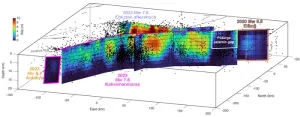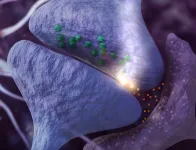(Press-News.org) April 20, 2023-- A new study by researchers at Columbia University Mailman School of Public Health shows that water arsenic levels are linked to higher urinary arsenic among the U.S. population for users of both private wells and public water systems. The findings are published in the journal Environmental Research.
Long-term exposure to arsenic even at low and moderate levels can increase the risk of cancer and other types of chronic disease. While drinking water along with diet is a major source of arsenic for the general population, the contribution of arsenic in drinking water to total arsenic exposure has been unclear in U.S. populations, especially at less than high levels in public water supplies.
The researchers evaluated the association between arsenic in private wells and public water supplies using urinary arsenic biomarkers within U.S. populations. “To date, no nationwide study had evaluated the link between drinking water arsenic with arsenic biomarkers in urine to assess how drinking water contributes to arsenic exposure for both regulated community water systems (CWS) and unregulated private wells,” said Maya Spaur, a PhD candidate in environmental health sciences at Columbia Mailman School of Public Health.
The U.S. Department of Health and Human Services Agency for Toxic Substances and Disease Registry includes arsenic as a potent carcinogen and toxicant associated with numerous adverse health outcomes, ranking it number one on their substance priority list. The U.S. Environmental Protection Agency (EPA) regulates arsenic in public drinking water supplies and sets the maximum contaminant level (MCL) allowable in public water systems. However, differences in CWS arsenic concentrations persist across the U.S.
In 2006, the EPA reduced allowable maximum contaminant levels to10 µg/L, from 50 µg/L. However, based solely on risk to health, the EPA set an MCL goal (MCLG) of 0 µg/L. In addition to community water systems, arsenic exposure from drinking water is also a major concern for approximately 40 million U.S. residents reliant on private well water. However private wells are not subject to EPA’s MCL or other federal regulations.
To conduct the study the researchers evaluated 11,088 participants from the 2003-2014 National Health and Nutrition Examination Survey (NHANES). For each participant, the researchers assigned private well and CWS arsenic levels according to county of residence using estimates previously derived by the U.S. Environmental Protection Agency and U.S. Geological Survey. Participants also completed an in-person interview, dietary recall, and physical examination.
The average recalibrated urinary dimethylarsinate (rDMA), the main metabolite of arsenic excreted in urine was 2.52 µg/L among private well users and 2.64 µg/L among CWS users. Urinary rDMA was highest among participants in the West and South, and among Mexican American, other Hispanic, and non-Hispanic other participants. Urinary rDMA levels were 25 percent and 20 percent higher comparing the highest to the lowest third of the population distribution of CWS and private well arsenic, respectively.
“We found that higher private well and public water arsenic levels were linked to higher urinary arsenic among NHANES participants,” noted Spaur. “We further observed very similar relationships between water arsenic and urinary arsenic for both regulated public water supplies and unregulated private wells, but did see differences by region with the strongest associations in the South and West, and among Mexican American participants. Our findings show that water arsenic, including in public water, is a major contributor to total arsenic as measured in urine. Additional efforts are needed to target regions and communities that continue to experience higher exposure.”
“Evaluating the link between drinking water arsenic and arsenic levels within U.S. populations is critical for informing drinking water regulatory policies going forward and for identifying communities that need additional financial, technical, and regulatory assistance to reduce the exposure to their residents,” said Anne E. Nigra, assistant professor of environmental health sciences at Columbia Mailman School of Public Health, and senior author.
Co-authors are Melissa Lombard and Joseph Ayotte, U.S. Geological Survey, New England Water Science Center; Benjamin Bostick and Steven Chillrud, Lamont-Doherty Earth Observatory of Columbia University; and Ana Navas-Acien and Anne Nigra, Columbia Public Health.
The study was supported by NIEHS grants P42ES010349 and P30ES009089, and F31ES034284, and by NIH/National Institute of Dental & Craniofacial Research grant DP5OD031849.
The authors declare that they have no known competing financial interests.
Columbia University Mailman School of Public Health
Founded in 1922, the Columbia University Mailman School of Public Health pursues an agenda of research, education, and service to address the critical and complex public health issues affecting New Yorkers, the nation and the world. The Columbia Mailman School is the fourth largest recipient of NIH grants among schools of public health. Its nearly 300 multi-disciplinary faculty members work in more than 100 countries around the world, addressing such issues as preventing infectious and chronic diseases, environmental health, maternal and child health, health policy, climate change and health, and public health preparedness. It is a leader in public health education with more than 1,300 graduate students from 55 nations pursuing a variety of master’s and doctoral degree programs. The Columbia Mailman School is also home to numerous world-renowned research centers, including ICAP and the Center for Infection and Immunity. For more information, please visit www.publichealth.columbia.edu
END
Water arsenic including in public water is linked to higher urinary arsenic totals among the U.S. population
Highest concentrations found in the West and South and among Mexican American and other Hispanic participants
2023-04-20
ELSE PRESS RELEASES FROM THIS DATE:
UHN Researchers publish ground breaking clinical trial in lung transplantation
2023-04-20
(Toronto, April 20, 2023) Storing donor lungs for transplant at 10 degrees Celsius markedly increases the length of time the organ can live outside the body according to research led by a team of scientists at the Toronto Lung Transplant Program in the Ajmera Transplant Centre at the University Health Network (UHN).
The prospective multicenter, nonrandomized clinical trial study of 70 patients demonstrated that donor lungs remained healthy and viable for transplant up to four times longer compared ...
Turkey’s next quake: USC research shows where, how bad — but not ‘when’
2023-04-20
Researchers know a lot about Turkey’s next major earthquake. They can pinpoint the probable epicenter, estimate its strength and see the spatial footprint of where damage is most likely to occur.
They just can’t say when it will happen.
That’s the main takeaway from a new USC-led study that appears today (April 20) in Seismica.
Using remote sensing, USC geophysicist Sylvain Barbot and his fellow researchers documented the massive Feb. 6 quake that killed more than 50,000 people in Eastern Turkey and toppled more than 100,000 buildings.
Alarmingly, researchers found that a section of the fault remains unbroken and locked – a sign that the plates there ...
Astrocyte dysfunction causes cognitive decline
2023-04-20
People with dementia have protein build-up in astrocytes that may trigger abnormal antiviral activity and memory loss, according to a preclinical study by a team of Weill Cornell Medicine investigators.
Dysfunction in cells called neurons, which transmit messages throughout the brain, has long been the prime suspect in dementia-related cognitive deficits. But a new study, published in Science Advances on April 19, suggests that abnormal immune activity in non-neuronal brain cells called astrocytes is sufficient to cause cognitive deficits in dementia. The discovery could lead to new treatments that reduce excess immune activity in astrocytes and their detrimental effects on other brain ...
UC Irvine biologists discover bees to be brew masters of the insect world
2023-04-20
Irvine, Calif., April 20, 2023 — Scientists at the University of California, Irvine have made a remarkable discovery about cellophane bees – their microbiomes are some of the most fermentative known from the insect world. These bees, which are named for their use of cellophane-like materials to line their subterranean nests, are known for their fascinating behaviors and their important ecological roles as pollinators. Now, researchers have uncovered another aspect of their biology that makes them even more intriguing.
According to a study published in Frontiers in Microbiology, cellophane ...
Sugar rush: scientists discover key role of glucose in brain activity
2023-04-20
SAN FRANCISCO, CA—April 18, 2023—The human brain has a sweet tooth, burning through nearly one quarter of the body’s sugar energy, or glucose, each day. Now, researchers at Gladstone Institutes and UC San Francisco (UCSF) have shed new light on exactly how neurons—the cells that send electrical signals through the brain—consume and metabolize glucose, as well as how these cells adapt to glucose shortages.
Previously, scientists had suspected that much of the glucose used by the brain was metabolized by other brain cells called ...
New study finds shifting climate regions leading to hotter, drier conditions across Kenya
2023-04-20
ST. LOUIS – Research published in Regional Environmental Change has shown that as climate zones shift toward hotter and drier conditions, ecological diversity will decline, posing a major threat to terrestrial ecosystems with far-reaching social and ecological impacts.
The study, “Shifting climate zones and expanding tropical and arid climate regions across Kenya (1980-2020),” was published online on April 5.
The research team analyzed Kenya's geographic distribution and arrangement of ...
Using solar farms to generate fresh desert soil crust
2023-04-20
In the arid regions of the American Southwest, an unseen world lies beneath our feet. Biocrusts, or biological soil crusts, are communities of living organisms. These industrious microbes include cyanobacteria, green algae, fungi, lichens, and mosses, forming a thin layer on the surface of soils in arid and semi-arid ecosystems.
Biocrusts play a crucial role in maintaining soil health and ecosystem sustainability, but they are currently under assault. Human activities including agriculture, urbanization, and off-road ...
COVID-19 pandemic saw major increase in children and adolescents attempting suicide by poison, study finds
2023-04-20
The rate of suspected suicide attempts by poisoning among children and adolescents ages 10-19 reported to U.S. poison centers increased 30% during 2021 – the COVID-19 pandemic’s first full year – compared with 2019, a new UVA Health study found.
The rate of suspected suicide attempts by poisoning among children ages 10-12 increased 73% during 2021 compared with 2019. Among adolescents ages 13-15, the rate of suspected suicide attempts by poisoning increased 48.8% in 2021 versus 2019. The rate of suspected suicide attempts by poisoning among females ages 10-19 increased 36.8% in 2021 compared with 2019.
The findings ...
Pairing up: the impact of treating alcohol use disorder and PTSD together
2023-04-20
A collaborative multi-site randomized controlled trial at the University of Houston and the Medical University of South Carolina is set to prove the effectiveness of treating alcohol use disorder (AUD) and posttraumatic stress disorder (PTSD) together.
It’s a one-two punch whose time has come. No integrative treatment combining Cognitive processing therapy (CPT) for PTSD and relapse prevention (RP) for AUD currently exists.
“A substantial proportion of individuals with AUD also meet criteria for PTSD. The co-occurrence of AUD/PTSD is characterized by more severe symptomatology, greater functional impairment, ...
IU cancer researchers identify new target for breast cancer therapy
2023-04-20
INDIANAPOLIS—While trying to understand what initiates breast cells to become cancerous, researchers at the Vera Bradley Foundation Center for Breast Cancer Research at Indiana University Melvin and Bren Simon Comprehensive Cancer Center have identified a new target for breast cancer treatment.
“When comparing healthy breast tissue and cancerous cells, we wanted to find out what is the earliest genomic change that happens to initiate the cancer,” said Harikrishna Nakshatri, PhD, the Marian J. Morrison professor of breast cancer research ...
LAST 30 PRESS RELEASES:
Making lighter work of calculating fluid and heat flow
Normalizing blood sugar can halve heart attack risk
Lowering blood sugar cuts heart attack risk in people with prediabetes
Study links genetic variants to risk of blinding eye disease in premature infants
Non-opioid ‘pain sponge’ therapy halts cartilage degeneration and relieves chronic pain
AI can pick up cultural values by mimicking how kids learn
China’s ecological redlines offer fast track to 30 x 30 global conservation goal
Invisible indoor threats: emerging household contaminants and their growing risks to human health
Adding antibody treatment to chemo boosts outcomes for children with rare cancer
Germline pathogenic variants among women without a history of breast cancer
Tanning beds triple melanoma risk, potentially causing broad DNA damage
Unique bond identified as key to viral infection speed
Indoor tanning makes youthful skin much older on a genetic level
Mouse model sheds new light on the causes and potential solutions to human GI problems linked to muscular dystrophy
The Journal of Nuclear Medicine ahead-of-print tip sheet: December 12, 2025
Smarter tools for peering into the microscopic world
Applications open for funding to conduct research in the Kinsey Institute archives
Global measure underestimates the severity of food insecurity
Child survivors of critical illness are missing out on timely follow up care
Risk-based vs annual breast cancer screening / the WISDOM randomized clinical trial
University of Toronto launches Electric Vehicle Innovation Ontario to accelerate advanced EV technologies and build Canada’s innovation advantage
Early relapse predicts poor outcomes in aggressive blood cancer
American College of Lifestyle Medicine applauds two CMS models aligned with lifestyle medicine practice and reimbursement
Clinical trial finds cannabis use not a barrier to quitting nicotine vaping
Supplemental nutrition assistance program policies and food insecurity
Switching immune cells to “night mode” could limit damage after a heart attack, study suggests
URI-based Global RIghts Project report spotlights continued troubling trends in worldwide inhumane treatment
Neutrophils are less aggressive at night, explaining why nighttime heart attacks cause less damage than daytime events
Menopausal hormone therapy may not pose breast cancer risk for women with BRCA mutations
Mobile health tool may improve quality of life for adolescent and young adult breast cancer survivors
[Press-News.org] Water arsenic including in public water is linked to higher urinary arsenic totals among the U.S. populationHighest concentrations found in the West and South and among Mexican American and other Hispanic participants




